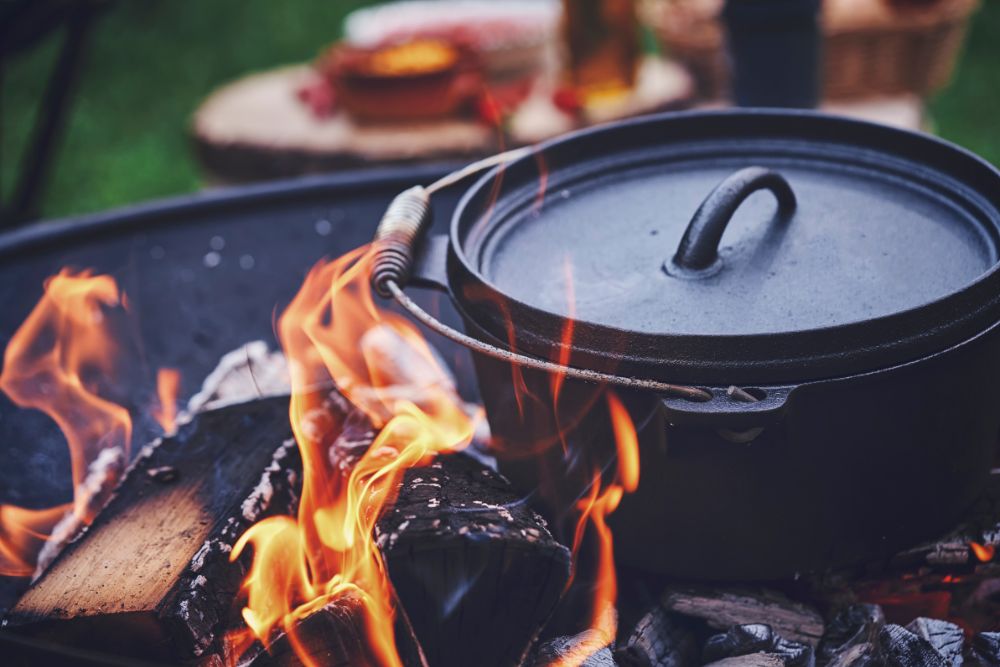Pros and Cons of Cooking with a Dutch Oven
Dutch ovens have been part of kitchens around the world for hundreds of years, prized for their durability, their flexibility, and their ability to facilitate rich, flavorful meals. They work well, whether over a fire, on the stove, or in the oven.
They have their pros and cons, but nevertheless, this article discusses the pros and cons of cooking in a Dutch oven to inform you as you determine if Dutch oven cooking fits your style and lifestyle.
|
|
Pros of Cooking In a Dutch Oven
1. Great Heat Retention
Dutch ovens really shine when it comes to retaining heat and spreading it evenly. This is ideal for slow-cooked foods such as stews, braises, soups and roasts. The walls of the pot are thick enough to keep the heat going, which in turn, keeps the heat even and prevents hot spots or uneven cooking.
2. Repairable
By far, the best thing about a Dutch oven is its versatility in cooking methods. You can use it for searing on the stove, roasting in the oven, cooking over a campfire, and baking artisan breads. I don’t know how many other things transition from varying cooking environments so easily.
3. Lasting
If you purchase a nice Dutch oven, most cast iron can last as long as you take care of it. I’ve seen Dutch ovens survive generations, and even wore-out and broken cases can easily be replaced. Enameled Dutch ovens add simplicity, because you won’t have to season them.
4. Complex Depth of Flavor
Because Dutch ovens retain moisture, they aren’t very helpful for building complex flavors, however, they are helpful in retaining and spreading heat. The sturdy lid holds in steam, which not only makes the meats extremely tender but also helps the sauces deepen and develop richer flavors. The pot promotes natural reduction and caramelization of the ingredients, which adds flavor.
5. Multi-Functional (One-Pot Meals)
Dutch ovens provide the perfect vessel for one-pot meals. You can brown meat, deglaze with a splash of wine, toss in some vegetables and stock, and then place the entire thing into the oven—without ever changing cookware. This saves time on clean-up and allows you to keep the flow of meal preparation.
6. Nutrient Retention
Long, slow cooking generally works to retain nutrients in vegetables and meats. Compared to cooking at high-heat or defrosting (or cooking!) in a microwave, the low-and-slow simmering process of a Dutch oven retains more vitamins and minerals.
7. Great Presentation
Many Dutch ovens (especially enamel-coated) are made with the presentation in mind. They are available in bright colors and attractive finishes that make them look beautiful on your table. You can serve directly from the pot to your table while keeping everything warm and in presentation.
8. Large Cookware Capacity
Many Dutch ovens are available in large sizes, which are great for larger family meals or to make meals in larger batches for yourself or to freeze. You can make a pot of soup for a crowd, or to meal-prep parts of the week… Dutch ovens can easily accommodate large amounts of food.
Negatives of Cooking with a Dutch Oven
1. Heavy! Bulky
One of the biggest negatives of cooking with a Dutch oven is the weight! A cast-iron Dutch oven can be very heavy, especially even when empty. Once filled with food, lifting or transferring it is difficult, especially if you don’t have much strength or mobility to lift it.
2. Can be Costly
There are many high-end brands, such as Le Creuset or Staub, that may run into the hundreds of dollars. While they make a good investment for those who cook at home often, the initial investment may be too costly for some. There are always cheaper options available for consumers but they may not last as long.
3. Needs care
Bare cast iron Dutch Ovens must be seasoned and cared for to keep them from rusting. Enameled Dutch Ovens, while simpler to care for, can get chips if they are dropped or carelessly handled, mostly on the sides or lid.
4. Takes longer to preheat
The thick body of Dutch Ovens takes longer to heat up. This may not be convenient if you need to cook something quickly. Once up to heat, they radiate heat long after the heat source has been removed which makes them ideal for low and slow recipes.
5. Not as ideal for quick cooking
While Dutch Ovens are the absolute best option for high-temperature slow cooking for hours to deepen flavor, they may not always be the most convenient and fastest pan to work with if you are short on time.
6. They aren’t always great on liquid glass cooktops
Dutch ovens can be troublesome on some glass or ceramic tops. The weight of the pot may scratch or ruin the glass or ceramic surface. It is best to always lift the pan—don’t slide it across the cooking top—as your glass or ceramic cooktop might not hold the weight of the cast iron when it is full. Always check the manufacturer guides.
7. Stains easily and discolorations
The interior of the Dutch oven is an enameled surface that is naturally a light color. Over time, light colors stain such as tomato-based recipes or multi-spices. Even though the surface is stained, there is no effect on cooking or cooking performance for heating or slow cooking, but the stain may strike the eye of some consumers as unpleasing.
8. Size and weight
The size and weight of a Dutch oven can be challenging for the consumer to produce for many preparers. It can take up space in cabinetry without any other items that it can be matched—saved for flatpan or sauce rambow. Not a great option for smaller kitchens, or for a consumer who prefers to keep their cookware collection simple.
Conclusion
For good reason Dutch Oven cooking is loved, and in almost all aspects the consumer will love the versatility of it. Flavor enhancement and durability of all forms of Dutch ovens are rare to be matched with any other product or cooking style, especially for long-drawn-out and slow cooking recipes.
Dutch ovens are great for foods like hearty stews, low-cooked ovens, crusty kinds of breads, and those one pot wonders! Dutch ovens are favored and loved by amateur chefs and the most experienced chef’s in all cooking homes of America, and the European experience also.
It is agreed that depending on your goals, and considering the benefits before watching a full install or a full food service, some points must be considered against the 8 advice points listed above to cooking in a Dutch oven style.
If time and energy into a recipe means working with food that takes a lot of time and care, and you are okay with the whole experience of handling a heavier cookware, then investing in a Dutch oven is the right enhanced choice for your cooking experience and culinary game.
Or if you want quick recipes and convenience for quick need and meals with options, it might be best to have the one thing to cook an evening meal around your week, but also as a second thought as part of a more complete sub-class of cookware options. But truly within each scenario—either scenario—they are one of the best timeless favorite cooking tools.

